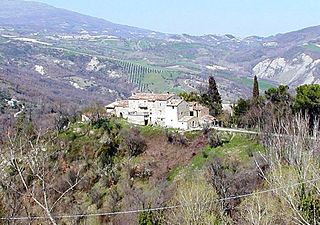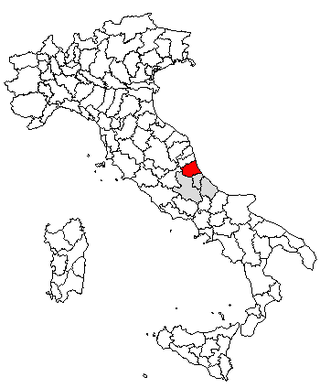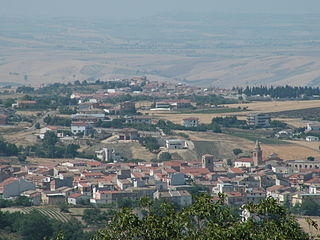
Apulia, also known by its Italian name Puglia, is a region of Italy, located in the southern peninsular section of the country, bordering the Adriatic Sea to the east, the Strait of Otranto and Ionian Sea to the southeast and the Gulf of Taranto to the south. The region comprises 19,345 square kilometers (7,469 sq mi), and its population is about four million people. It is bordered by the other Italian regions of Molise to the north, Campania to the west, and Basilicata to the southwest. The regional capital is Bari.

Abruzzo, historically known as Abruzzi, is a region of Southern Italy with an area of 10,763 square km and a population of 1.3 million. It is divided into four provinces: L'Aquila, Teramo, Pescara, and Chieti. Its western border lies 80 km (50 mi) east of Rome. Abruzzo borders the region of Marche to the north, Lazio to the west and north-west, Molise to the south and the Adriatic Sea to the east. Geographically, Abruzzo is divided into a mountainous area in the west, which includes the highest massifs of the Apennines, such as the Gran Sasso d'Italia and the Maiella, and a coastal area in the east with beaches on the Adriatic Sea.

The Mesta was a powerful association protecting livestock owners and their animals in the Crown of Castile that was incorporated in the 13th century and was dissolved in 1836. Although best known for its organisation of the annual migration of transhumant sheep, particularly those of the Merino breed, the flocks and herds of all species of livestock in Castile and their owners were under the oversight of the Mesta, including both the transhumant and the sedentary ones. The transhumant sheep were generally owned in Old Castile and León, where they had their summer pastures, and they migrated to and from winter pastures of Extremadura and Andalusia according to the season.

The Apennines or Apennine Mountains are a mountain range consisting of parallel smaller chains extending c. 1,200 km (750 mi) along the length of peninsular Italy. In the northwest they join with the Ligurian Alps at Altare. In the southwest they end at Reggio di Calabria, the coastal city at the tip of the peninsula. Since 2000 the Environment Ministry of Italy, following the recommendations of the Apennines Park of Europe Project, has been defining the Apennines System to include the mountains of north Sicily, for a total distance of 1,500 kilometres (930 mi). The system forms an arc enclosing the east side of the Ligurian and Tyrrhenian seas.

Transhumance is a type of pastoralism or nomadism, a seasonal movement of livestock between fixed summer and winter pastures. In montane regions, it implies movement between higher pastures in summer and lower valleys in winter. Herders have a permanent home, typically in valleys. Generally only the herds travel, with a certain number of people necessary to tend them, while the main population stays at the base. In contrast, horizontal transhumance is more susceptible to being disrupted by climatic, economic, or political change.

The province of Foggia is a province in the Apulia region of Italy.

The Maremmano-Abruzzese Sheepdog, also known as the Maremmano, Maremma Sheepdog, or Abruzzese Sheepdog, among other names, is an Italian breed of livestock guardian dog. It is indigenous to Central Italy, especially to the Maremma region of Tuscany and Lazio, and to northern areas of Southern Italy, particularly to Abruzzo. It has been used for centuries by Italian shepherds to guard sheep from wolves. The "Maremmano" name derives from that of the Maremma marshlands where, until recently, shepherds, dogs and hundreds of thousands of sheep over-wintered, and where the dogs are still abundant although sheep-farming has decreased substantially. However, the breed is still widely employed in and closely culturally associated with the nearby region of Abruzzo, where sheep herding remains vital to the rural economy and the wolf remains an active and protected predator.

Foggia is a city and comune (municipality) of Apulia, in Southern Italy, capital of the province of Foggia. In 2013, its population was 153,143. Foggia is the main city of a plain called Tavoliere, also known as the "granary of Italy".
Ordona is a small town and comune of the province of Foggia in the region of Apulia in southern Italy.

Pescasseroli is a town and comune in the province of L'Aquila, in Southern Abruzzo, central Italy.
Nomadic pastoralism is a form of pastoralism in which livestock are herded in order to seek for fresh pastures on which to graze. True nomads follow an irregular pattern of movement, in contrast with transhumance, where seasonal pastures are fixed. However, this distinction is often not observed and the term 'nomad' used for both—and in historical cases the regularity of movements is often unknown in any case. The herded livestock include cattle, water buffalo, yaks, llamas, sheep, goats, reindeer, horses, donkeys or camels, or mixtures of species. Nomadic pastoralism is commonly practised in regions with little arable land, typically in the developing world, especially in the steppe lands north of the agricultural zone of Eurasia.

Valle Soprana is a small village in the province of Teramo, in the Abruzzo region of central Italy. It is a frazione of the town of Teramo.

Villa Popolo is a small village in the province of Teramo, in the Abruzzo region of central Italy. It is a frazione of the comune of Torricella Sicura.

Casalvecchio is an Arbëreshë comune and village in the Province of Foggia, Apulia, southern Italy. Mostly originating from a 15th-century migration of Albanians, the residents have subsisted by family farming. Of those native to the area for generations, many have continued to use Arbëresh, even those of the post–World War II generation.

Monti della Laga is a mountain range in the central Apennines of Italy. Their ruggedness and inaccessibility makes them one of the lesser known areas of the Italian peninsula.

Calascio is a comune and village in the province of L'Aquila, in the Abruzzo region of central Italy. It is located in the Gran Sasso e Monti della Laga National Park.

Castel del Monte is a medieval and Renaissance hill town and comune in the province of L'Aquila in northern Abruzzo, Italy. Located in the heart of the Gran Sasso mountain range, the town is set into a steep hillside nestled beneath mountain peaks near the high plain of Campo Imperatore. Castel del Monte sits opposite the ancient mountaintop fortress of Rocca Calascio and faces Monte Sirente in the distance. It is located in the Gran Sasso e Monti della Laga National Park. It is one of I Borghi più belli d'Italia.

The Tavoliere delle Puglie is a plain in northern Apulia, southern Italy, occupying nearly a half of the Capitanata traditional region. It covers a surface of c. 3,000 km2, once constituting a sea bottom: it is bounded by the Daunian Pre-Apennines on the West, the Gargano Promontory and the Adriatic Sea on the East, by the Fortore river on the north, and the Ofanto river on the south. It is the largest Italian plain after the Pianura Padana.

The Altopiano delle Murge is a karst topographic plateau of rectangular shape in southern Italy. Most of it lies within Puglia and corresponds with the sub-region known as Murgia or Le Murge. The plateau lies mainly in the Metropolitan City of Bari and the province of Barletta-Andria-Trani, but extends into the provinces of Brindisi and Taranto to the south, and into Matera in Basilicata to the west. The name is believed to originate from the Latin: murex, meaning 'sharp stone'.

Alpine transhumance is transhumance as practiced in the Alps, that is, a seasonal droving of grazing livestock between the valleys in winter and the high mountain pastures in summer. Transhumance is a traditional practice that has shaped much of the landscape in the Alps, as without it, most areas below 2,000 m (6,600 ft) would be forests. While tourism and industry contribute today much to Alpine economy, seasonal migration to high pastures is still practiced in Bavaria, Austria, Slovenia, Italy, France and Switzerland, except in their most frequented tourist centers. In some places, cattle are taken care of by local farmer families who move to higher places. In others, this job is for herdsmen who are employees of the cooperative owning the pastures.

















